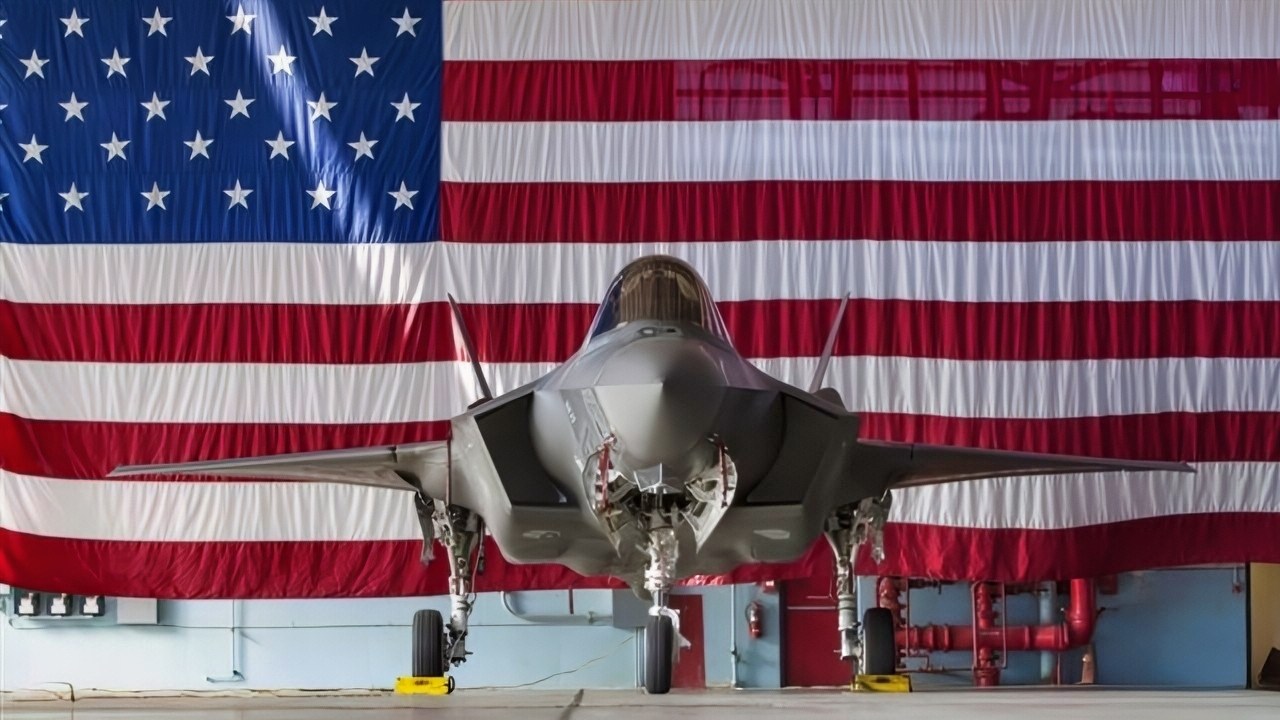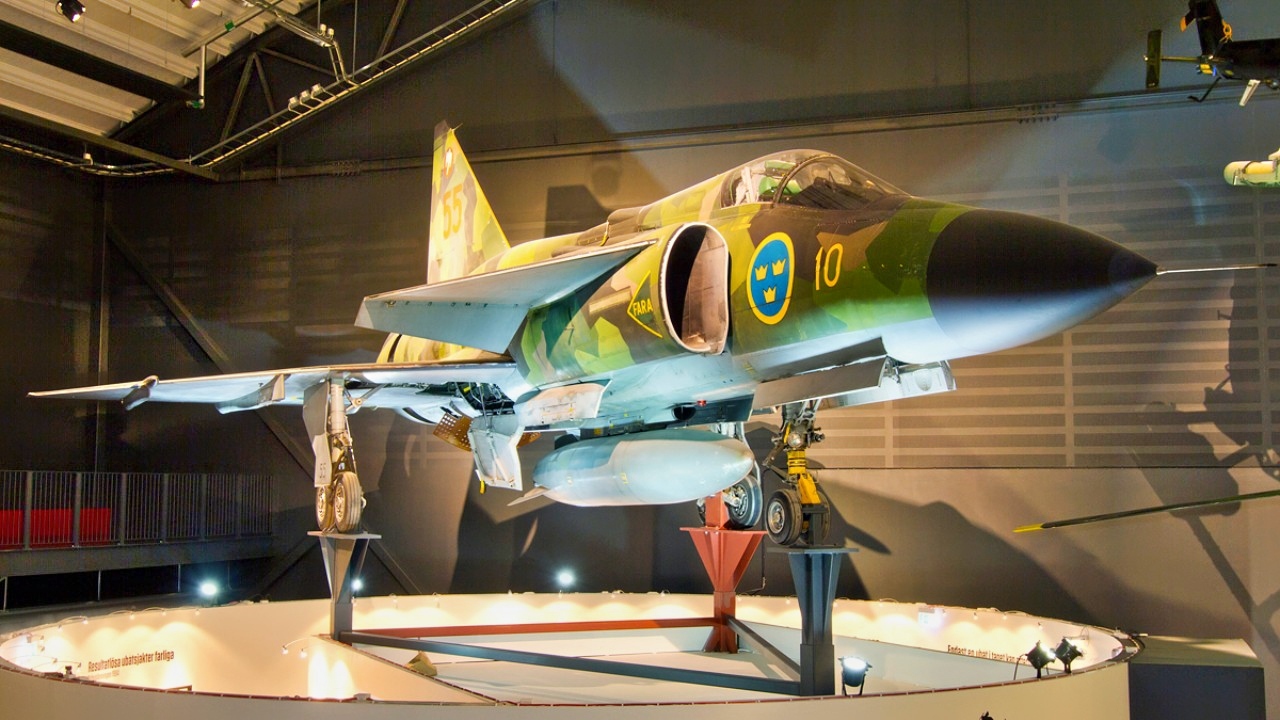Key Points and Summary – Sweden’s latest Gripen export wins are part of a much deeper story: a small country using homegrown fighters to carve out real independence from U.S. airpower.
-That tradition began with the odd-looking Saab 29 “Flying Barrel,” a stubby early jet that proved unexpectedly fast, agile, and combat-credible.

Flygsystem 2020 from Saab. Image Credit: Saab.
-Its success showed Sweden could design and mass-produce frontline fighters without relying on Washington or Moscow.
-Today, as European governments quietly worry about political strings and supply-chain dependence tied to the F-35, Saab is selling that same promise of sovereign control—this time with Gripen, and on a much bigger stage.

F-35 Fighter Image by Lockheed Martin
How Sweden Is Challenging U.S. Dominance – Starting With the Saab 29 Flying Barrel
Amidst growing murmurs throughout Europe about the future of dependence on American fighter jets – including the F-35 – Sweden’s fighter-jet industry is receiving growing international attention.
A series of Gripen export developments through Europe, Asia, and Latin America suggest that the United States’ dominance could soon be challenged; Hungary confirmed it would expand its fleet with four additional Gripen C/Ds in 2024, Brazil continues to receive deliveries of the next-generation Gripen E, and Saab recently signed a $3.6 billion deal with the Colombian government for 15 Gripen E/S.
We’re not talking F-35 numbers here, but it’s significant nonetheless. It’s a cluster of activity that has drawn fresh attention to Sweden’s long-standing ability to build competitive fighters despite its modest size.
And, to understand why this matters in the grand scheme of things, it helps to look back at Sweden’s history. The Saab 29 Tunnan is perhaps one of the best examples of how Sweden can succeed against the odds.
The Saab 29 Barrel Fighter That Shouldn’t Have Worked
When the Saab 29 first flew in 1949, few expected much from the jet – and it was in large part because of how it looked. The Tunnan has long been compared to a beer keg. Its stubby, rounded fuselage earned it the nickname “Flygande Tunnan” – or the “Flying Barrel” in the Swedish Air Force.
Yet that unconventional shape ultimately worked. It wasn’t an aesthetic mistake but a deliberate product of Sweden’s first attempt to integrate swept-wing aerodynamics into an aircraft, reflecting research traceable to German wartime studies seized after 1945.
Because early centrifugal-flow jet engines required a large internal volume for fuel and intake ducting, there was little other choice than to make the fuselage as large as possible – and designers simply settled on that fact as the cost of achieving new heights of aviation performance.
The result was one of the most surprisingly capable early jet fighters outside of the United States and the Soviet Union.
In 1954, the Tunnan also set a new world speed record on a closed circuit, averaging 977 km/h. And even despite that weird design, it proves highly maneuverable in service, too. It appears clumsy, but pilots reported that it was stable at high angles of attack, and performed well even in the harsh Nordic environment. It was so good, in fact, that Sweden produced more than 660 of the aircraft – a frankly extraordinary number for a nation (and industry) of its size.
Its combat deployment was impressive, too. During the United Nations’ Congo Crisis in the early 1960s, Swedish Tunnans flew ground-attack and reconnaissance missions for the UN Operation in the Congo, making the Saab 29 one of the few European-designed jets of its era to see combat under UN command.
It’s an impressive history, and a story that proved that a small neutral country like Sweden could design, mass-produce, and field world-class combat aircraft without reliance on U.S. or Soviet supply chains. And it’s something Sweden – and many European countries – are hoping can be recreated as we welcome in a new generation of fighter jets.
But that desire for independence is no longer only a Swedish ambition; it is increasingly a European one.
Europe Leans Toward Sovereign Systems
As governments look ahead to the next 30 years of airpower, several NATO states are now questioning whether the long-term costs, political constraints, and supply-chain dependencies of the F-35 program leave too little room for national autonomy.
The F-35’s mission-date files, software upgrades, and sustainment all remain under tight American control – a point of concern for countries seeking greater sovereignty over their systems. And it’s against this backdrop that Saab’s recent export momentum really matters.

Saab 35. Image Credit: Creative Commons.
The debate in Canada over the future of its F-35 fleet, and the possibility of operating a mixed F-35/Gripen fleet, is even more consequential. Swedish officials and Saab representatives are pushing hard to make the deal, promising to bring jobs to Canada’s manufacturing industry and establishing a domestic supply chain – something Saab has said could generate as many as 10,000 jobs within five years.

Saab 37 Viggen Fighter. Image Credit: Creative Commons.
And while it’s still perfectly possible that Saab will get the deal, Sweden is not without competition to dethrone the U.S. in the long run. France’s Dassault Rafale has become Europe’s other major non-U.S. competition, winning orders from Croatia, Greece, and the UAE, all the while positioning itself as a sovereignty-first alternative to American platforms.
It’s hard to say who will win, or even if sovereignty will be such an important political point that it will eventually trump the sheer power and superiority of American current- and next-generation systems.
But now may be the moment that Sweden’s long tradition of aviation independence and innovation – starting with the Flying Barrel – becomes one of its most substantial export advantages.
About the Author:
Jack Buckby is a British author, counter-extremism researcher, and journalist based in New York who writes frequently for National Security Journal. Reporting on the U.K., Europe, and the U.S., he works to analyze and understand left-wing and right-wing radicalization, and reports on Western governments’ approaches to the pressing issues of today. His books and research papers explore these themes and propose pragmatic solutions to our increasingly polarized society. His latest book is The Truth Teller: RFK Jr. and the Case for a Post-Partisan Presidency.
More Military
The F-35 Fighter Is In More Trouble Than You Think
Was USS Wasp Really the Worst U.S. Navy Aircraft Carrier?
The Navy Had a Nuclear Submarine That Could Tap Russia’s Undersea Cables and Self Destruct
The U.S. Navy’s Flying Aircraft Carrier Mistake Still Stings










